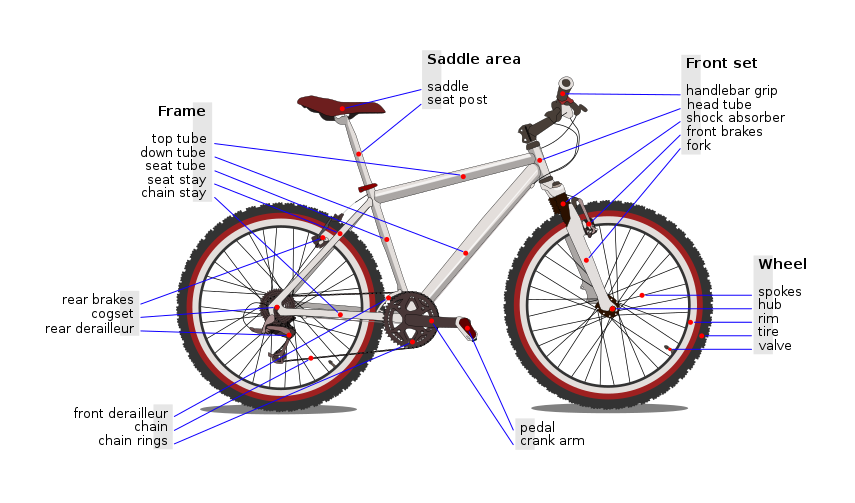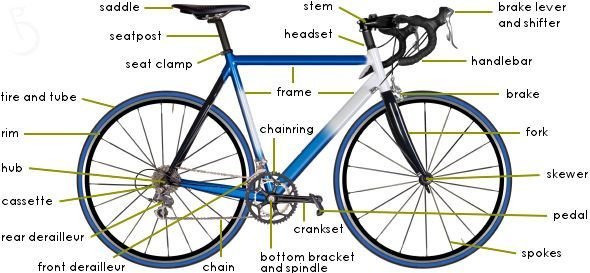Know all the parts of a bike
Each part of a bike has its importance. No matter how small it is.
In the same way that a junior doctor must learn to name all the bones of the human skeleton, a cyclist should be able to name all the parts of his bike. If only to make sure he can order spare parts without embarrassment.
Here is a story that I witnessed not long ago:
‘Mr. Shopkeeper, can I have one of those doo-dads that’s a bit like an oxygen cylinder but only a little slimmer? They’re used to force air into tires. They’re kind of like … well, a …?’
‘You mean a bicycle pump for inflating your tires?’
‘Yes, that’s it! Could I have one of those please?’
What I mean by the above discussion is that I would not like to go to a shop and be in that position. And I’m sure you would not like that either. So let’s not let ignorance lead to conversations like this.
This is why I put together the below section explaining all the parts of a bicycle.
I amazed myself by knowing the vast majority of these already – like ‘wheels’ and ‘handlebars’. I didn’t count all the parts but it looked from the diagram like there might be a couple that is worth knowing.

source wikipedia.org
I have a friend whos is in the same situation. He is always keen to avoid learning the names. He, instead, takes a diagram to the repair shop and point at the parts he wants. Unfortunately, the above parts of a bike diagram do not show all of the different items that you need to get a complete bike.
For instance, it does not show that little device that looks like an oxygen cylinder, but only slimmer. 🙂
And by the way, my friend is not going to try to pronounce ‘derailleur’ in a crowded shop. I am sure you know what I mean by that. 🙂
What are the different parts of a bike?
So, we’ve reached the stage when you just want to mount that bike and ride your heart out. There’s just one problem — you haven’t a clue how to tell one part of a bike from another. You think a derailleur is someone who’s gone off the rails. Have faith. It’s not that difficult. You will quickly learn to identify each part and how it functions.
What you need to know is that parts of a road bike or parts of a mountain bike are the same. There are just very few differences, but the words we use for one are the same for the other.
What I will cover below are all the parts of a bike that the most common and you can find on your bike. Nothing more, nothing less.
The photo below identifies all the main parts for a road bike. When you compare this picture and the one above, you’ll see that the parts are quite common.
Summary of the different parts of a road bike diagram
- Handlebars: These come in a variety of shapes but the function is the same. They are what you hold onto to steer and control the bike.
- Levers or shifters: Levers or shifters come attached to handlebars. Their function is to change the gears. Usually, the left lever moves the chain from the big chainring in the front to the smaller one for big gear shifts. The right lever controls the chain shift on the back cogs which is used for small- er gear shifts.
- Brake Levers: Used to slow the bike in combination with the gear shifter. The left one usually works the rear brake and the right one, the front.
- Brake: These pads slow the wheel. With hydraulic brakes, the brake disc is located on the central part of the wheel. Derailleur: These guide the chain to each of the chainrings in the front and cogs on the back cassette.
- Cassette: The cogs on the back wheel.
- Chainring: The big rings attached to the pedal. The biggest ring is the hard- est to pedal.
- Seat or Saddle: This is what you sit on. They come in all shapes and sizes. Pick one that suits you.
- Cranks and Pedals: The pedal is the flat section you place your foot. The crank is the arm the pedal is attached to. Some pedals are designed for clip-in shoes while others are clip-less, attaching to a special cleat on riding shoes.
- Wheels: The outer section holds the tires and is connected to the central hub by the spokes.
- Tires: These are the outer parts of the wheel that make ground contact and contain the inflated tube inside. They vary in size and shape depending on the type of bike and riding surface.
- Forks: These are the part of the bike the wheel is attached to. Tubes: The frame of the bike Cables: These are the wires that connect the levers to the brakes and derailleurs.
What are the different types of bicycles?
Now that you know about the different parts of a road bike, you definitely need to know the different bikes available out there.
You need to choose a bike suitable for your preferred type of riding. Any bike will get you from A to B but you might as well get one that is comfortable and suited to your ride.
Road Bikes. Designed to be ridden on the road, these light, easy-to-maneuver, aerodynamic and responsive bikes make for a fast, efficient ride.
Mountain Bikes. Designed to be ridden off-road. Their design reflects the rougher terrain they have to handle: Shock absorbers and large tires to smooth a rough ride; flatter handlebars and frame design to position the rider in a more upright position compared to a road bike. You can ride these on the road but they will give you a slower ride. If you plan to do on-road and off-road riding, consider a hybrid bike.
Hybrid Bikes. A cross between mountain bikes and road bikes. They don’t have the suspension features of a full mountain bike but they will enable you to ride at a reasonable pace on the road while providing a comfortable off-road ride. They have flatter handlebars and medium-width tires for a more upright ride. Hybrid bikes are more suitable for new riders as the riding position is more upright and instills more confidence in the inexperienced.
There are many other types of bikes such as cruiser bike, single-speed bike, etc. but they are all related to one of the above three types.
What parts to check when buying a second-hand bike?
If you’re purchasing a second-hand bike, get a competent bike mechanic or regular cyclist to check it out.
As a rule of thumb and over time, check the cables as they rust and the bearings too as they seize.
Look at the rubber on the tires, the spokes, and if the rims are straight or bent. All all these will allow you to make a decision, but also to decide if you want to negotiate.
I have to say that by getting your bike checked thoroughly before use, you’ll lessen the chance of gear failure spoiling your ride and denting your confidence.
By the way, make sure that the bike has been adjusted to suit your body.
Ensure that you have an easy foot contact with the ground when coming off the pedals.
It is a fact that new riders often set their seats too low or too high. Correct seat and handlebar positions are essential to ensure a comfortable ride that won’t put a strain on your body parts.
What parts do you need to ride a bike?
Clothing & Gear – Choose clothing and gear that is comfortable and that will keep you safe. Consider the terrain you’ll be cycling through and what the climate is like there. Check the weather before you leave and take appropriate clothing. Here are some items to make your ride more pleasurable.
Shorts – You can opt for shorts instead of your day to day clothes. Cycling shorts use chamois leather as protection against chafing and to offer a more comfortable ride. Lycra prevents abrasion on the skin and prevents moisture from being held close to the skin. Trust me — once accustomed to cycling in these shorts you will never go back to regular shorts. Visit your local cycle shop and check out the different types of bikes available.
Helmet – Road surfaces can be unforgiving. Most riders come off their bike sooner or later and a good helmet helps prevent serious head injuries. Make sure the straps are tight enough to prevent the helmet from sliding back on your head.
Socks – While you could use any socks, sports socks are better in the long run. Gloves Fingerless work best. But if it’s cold, use full finger gloves (thermal if possible).
Cycling jersey – Cycling jerseys are longer in the back so they don’t ride up your back and expose your skin to the elements when you lean forward. They have pockets in the lower back and sides for easy access.
Jacket – A lightweight jacket is essential to protect you from the rain. The best of these are of an ultra-lightweight type that can be folded into your back pocket. Make sure when buying any product designed to keep you dry, that you know the difference between ‘waterproof’ and ‘water-resistant’. To be considered waterproof an item must be made of waterproof fabric with sealed seams. ‘Water-resistant’ items are made from materials that repel water but which are not waterproof.
Cycle shoes – New cyclists are often concerned about clipless cycling shoes. What if they are unable to disengage in time before dismounting? If you are concerned you could start with cage pedals, though most riders progress to clipless due to the greater efficiency and comfort they provide.
What tools and spare parts you need for cycling?
Most cyclists carry a few tools and spares. These are kept in a small bag that hooks under the bicycle seat. Bare essentials include:
- Spare tube
- CO2 tire inflator if you don’t have a pump attached to the bike frame
- Two tire levers
- Small multi-tool
- Water bottle and cage (attached to the bike frame)
Conclusion
Having a list of bike parts needed to build a bike or a diagram showing all of the different items is something that you should have. I would advise you to print one of these lists or diagrams and hang them in the garage near your bike.
There is nothing wrong with getting the experts to show you the difference between the vast number of bikes out there and explaining you how to use these. While you’re there, have a look at the gear available and ask what’s suitable for your level of riding.

